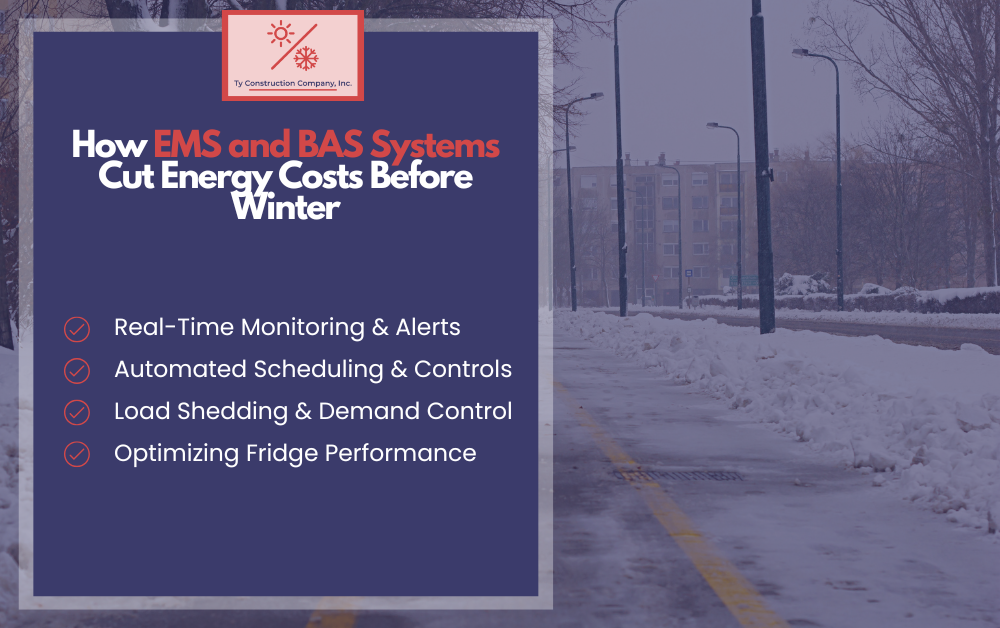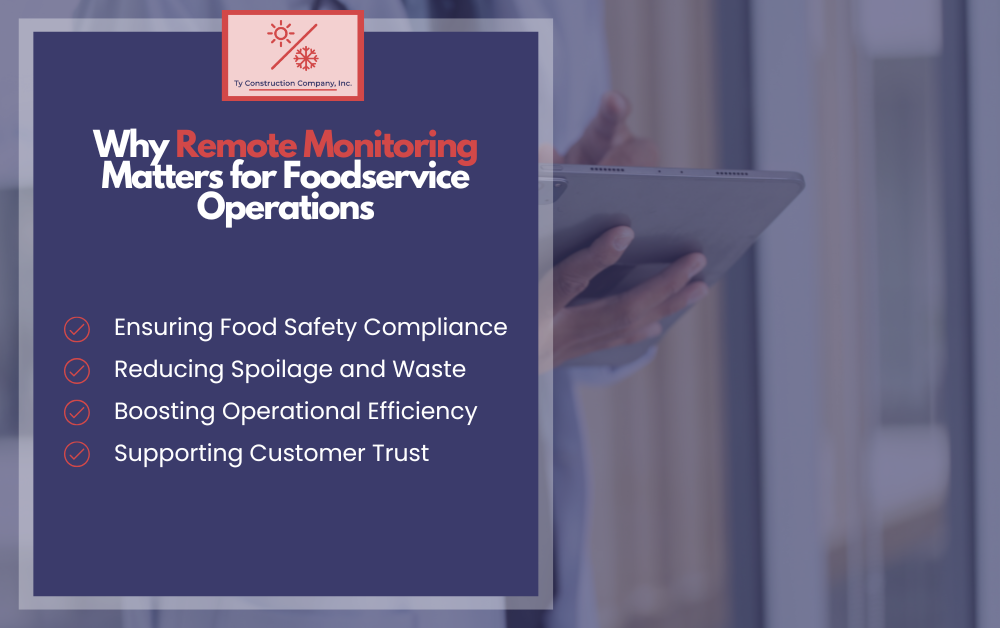As winter approaches, energy costs start climbing for businesses across the foodservice, retail, and commercial industries. Heating demands increase, equipment runs harder, and inefficiencies quickly become expensive. This is where EMS and BAS systems make the difference. Energy Management Systems (EMS) and Building Automation Systems (BAS) give business owners the ability to track, control, and optimize energy use in real time. Instead of reacting to high bills or sudden breakdowns, operators can take a proactive approach to efficiency.
In this blog, we’ll explore what EMS and BAS are, how they work together, and why they’re essential for cutting energy costs before winter sets in.
What Are EMS and BAS Systems?
EMS (Energy Management Systems): EMS is a technology platform that collects and analyzes data about your energy use. It identifies patterns, inefficiencies, and opportunities for cost savings.
BAS (Building Automation Systems): BAS takes things a step further by directly controlling systems like HVAC, refrigeration, and lighting. With automation, businesses can adjust schedules, respond to real-time conditions, and maintain consistent performance across facilities.
How They Work Together
EMS and BAS complement each other. EMS provides the data and insights, while BAS executes changes automatically. For example:
- EMS identifies that a walk-in cooler is running inefficiently.
- BAS adjusts the refrigeration cycle to maintain temperature without wasting energy.
Together, they create a powerful solution for reducing energy use while ensuring critical systems stay reliable.
Why Winter Demands Smarter Energy Management
Rising Heating Costs
During colder months, heating costs spike significantly. Commercial HVAC systems run harder and longer, which means small inefficiencies translate into large bills. EMS and BAS systems catch those inefficiencies before they get out of control.
Holiday and Seasonal Demand
For many businesses, November and December bring higher customer traffic. Supermarkets and restaurants run refrigeration, HVAC, and lighting systems at maximum capacity to keep up. Without EMS and BAS, this seasonal surge leads to higher demand charges and wasted energy.
Risk of Equipment Failure
Cold weather places stress on heating and refrigeration systems. If equipment isn’t running at peak efficiency, the chance of breakdowns rises. Remote monitoring through EMS and BAS detects these issues early, preventing downtime during the busiest season of the year.
How EMS and BAS Systems Cut Costs
Real-Time Monitoring and Alerts
EMS and BAS systems monitor refrigeration and HVAC performance continuously. If temperatures drift out of range or energy consumption spikes, managers get instant alerts. That allows quick fixes before problems escalate into costly failures or wasted energy.
Automated Scheduling and Controls
Automation is one of the most valuable features. With BAS, businesses can schedule HVAC and lighting around actual operating hours. For example, heating and lighting can automatically scale back after closing time, ensuring energy isn’t wasted when the building is empty.
Load Shedding and Demand Control
Utility companies often charge extra for energy used during peak demand hours. EMS and BAS help businesses reduce consumption during those times by shifting loads, balancing equipment use, and cutting demand spikes. This saves money without sacrificing comfort or food safety.
Optimizing Refrigeration Performance
Refrigeration is one of the largest energy consumers in foodservice and retail. EMS systems identify units that are drawing excess power, running too frequently, or failing to maintain temperature. BAS can then adjust operations to improve efficiency, extend equipment life, and keep food safe.
Additional Benefits Beyond Energy Savings
Compliance and Safety
In industries like foodservice, compliance with food safety standards is critical. EMS and BAS systems automatically log refrigeration temperatures and system performance, creating digital records that make health inspections simple and stress-free.
Reduced Equipment Wear and Tear
When equipment operates efficiently, it doesn’t have to work as hard. This reduces strain, prevents premature breakdowns, and extends the lifespan of HVAC and refrigeration units.
Sustainability Goals
Reducing energy consumption isn’t just good for the bottom line — it’s good for the environment. Many businesses now prioritize sustainability as part of their brand promise. EMS and BAS systems help lower carbon footprints and meet corporate or regulatory sustainability goals.
Real-World Applications of EMS and BAS in Foodservice
Restaurants
Restaurants rely on multiple refrigeration systems and HVAC to keep kitchens comfortable. EMS and BAS allow owners to monitor prep coolers, walk-ins, and dining room HVAC systems in real time. They can also prevent wasted energy by automatically scaling back systems during closed hours.
Grocery Stores and Supermarkets
With dozens of refrigeration units and large HVAC demands, grocery stores have some of the highest energy use per square foot of any retail operation. EMS and BAS provide centralized control, enabling managers to oversee entire store systems from one dashboard. During holiday rushes, this visibility prevents both costly outages and skyrocketing bills.
Convenience Stores
Convenience stores often operate with fewer staff but still run critical refrigeration and HVAC systems around the clock. EMS and BAS make it easier to protect grab-and-go foods, monitor coolers, and manage lighting automatically. This ensures compliance without adding more workload for employees.
Steps to Implement EMS and BAS Before Winter
Assess Your Current Energy Use
Start with an energy audit. By reviewing your current usage, you can identify which systems are consuming the most energy and where improvements will have the greatest impact.
Work with Certified Professionals
Professional installation and setup are essential for success. Certified technicians can integrate these systems with your existing equipment and configure them for optimal performance.
Train Staff and Set Schedules
Even the best technology needs people who know how to use it. Train staff to understand alerts, review reports, and respond appropriately. Establish HVAC and lighting schedules that reflect your true operating hours.
The ROI of EMS and BAS Systems
Short-Term Savings
Businesses often see reduced utility bills after their first season using EMS and BAS. Avoiding a single emergency repair or food spoilage incident can save thousands of dollars.
Long-Term Value
Over time, they pay for themselves. Extended equipment lifespan, consistent energy savings, and improved compliance create long-term financial and operational benefits.
Cut Winter Energy Costs with EMS and BAS
Winter brings higher heating demands, increased customer traffic, and more stress on commercial refrigeration and HVAC systems. Without a strategy, energy bills can quickly spiral out of control.
By investing in EMS and BAS systems, businesses gain control over energy use, protect equipment, and ensure compliance — all while cutting costs and improving efficiency. From restaurants and supermarkets to convenience stores, these systems deliver real-time oversight, automation, and peace of mind.
Don’t wait until energy bills spike. Contact Ty Construction Company, Inc. today to explore EMS and BAS solutions that will help your business cut costs, stay compliant, and thrive this winter.







